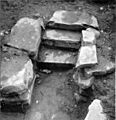Tidaholm facts for kids
Quick facts for kids
Tidaholm
|
||
|---|---|---|
|
Founded as a city in 1910
|
||

Vättaks Church in Tidaholm, Sweden.
|
||
|
||
| Country | Sweden | |
| Province | Västergötland | |
| County | Västra Götaland County | |
| Municipality | Tidaholm Municipality | |
| Area | ||
| • Total | 5.70 km2 (2.20 sq mi) | |
| Population
(31 December 2020)
|
||
| • Total | 12,790 | |
| • Density | 1,408/km2 (3,650/sq mi) | |
| Time zone | UTC+1 (CET) | |
| • Summer (DST) | UTC+2 (CEST) | |
| Climate | Dfb | |
Tidaholm is a town in Sweden. It is the main town of Tidaholm Municipality. The town is in Västergötland Province. This province is part of Västra Götaland County. Tidaholm covers about 5.70 square kilometers. The town sits on the Tidan River. This river is special because it is the only one in Sweden that flows north.
Tidaholm Municipality includes two islands. These are Vulcanön and Turbinhusön. Vulcanön used to be the main industrial area. Turbinhusön once had a turbine. In 2020, about 12,790 people lived in Tidaholm.
Contents
Tidaholm's History
Tidaholm was once called Agnetorp. It became a "merchant town" in 1895. This meant it was a special place for trade. In 1910, Tidaholm officially became a city. Since 1974, it has been the main town for the larger Tidaholm Municipality. The county it belongs to also changed. In 1997, several counties joined together. They formed the new Västra Götaland County.
From Farms to Factories
Until the early 1800s, Tidaholm was mostly a farming community. But in 1799, an ironworks factory started. It was called Tidaholms Bruk. This factory was built where an old forge had been since the Middle Ages. Tidaholms Bruk grew. It made furniture, wagons, and farm tools.
Later, a man who studied car making in the United States came back to Sweden. He helped create the "Tidaholm car." Most parts for these cars were made at Tidaholms Bruk. They even started making engines in 1914. Between 1903 and 1934, the factory made about 6,000 vehicles. These were mainly trucks, buses, and fire trucks. These vehicles were called "Tidaholmarna." You could see them in places like Oslo and St. Petersburg.
The Match Factory
In 1868, the Vulcan match factory opened. It was built on Vulcan Island. This island is in the Tidan River. The factory started with just over 100 workers. By the early 1900s, it was huge. It became the biggest match maker in the world. More than 1,000 people worked there.
Today, Vulcan Tidaholm is the only match factory left in Sweden. It has about 200 employees. The old factory building now holds the Lithographic Art Workshop. This workshop continues Tidaholm's history of art. This art started with designing cool matchbox labels.
Industrial Pictures
Tidaholm's Islands
Vulcanön Island
Both Tidaholms Bruk and Vulcan Tidaholm factories were on Vulcanön island. Today, the Tidaholm Museum is here. The museum shows the town's industrial past. It focuses on the car and match industries. You can see nine Tidaholms Bruk cars there. Many old buildings were taken down, but some historic ones remain.
Turbinhusön Island
Turbinhusön island has an art gallery. It is in the old turbine house. This gallery is open in the summer. Near Hellidens folkhögskola, you will find Sweden's only Lithographic Museum. There are also cafes and small shops on this island.
Places to Visit
- Gamla Torget — This is the city square. Many old 19th-century buildings surround it. It is a main gathering place for local events.
- Idrottshistoriska Museet — This Sports Museum shows the history of local sports. It celebrates local athletes and teams.
- Tidaholms Stadsbibliotek — The public library is in an old building. It was built in the late 1800s. The library also hosts temporary art shows.
Architectural Pictures
Helliden Castle
Hans Henrik Von Essen was important to Tidaholm. He owned Tidaholms Bruk. He also helped start Vulcan Tidaholm. In 1858, he built Helliden. This was a large manor house. People often call it Helliden Castle. It is on the edge of the municipality. Today, it is a high school. It also has a center for adult education.
See also
 In Spanish: Tidaholm para niños
In Spanish: Tidaholm para niños





















